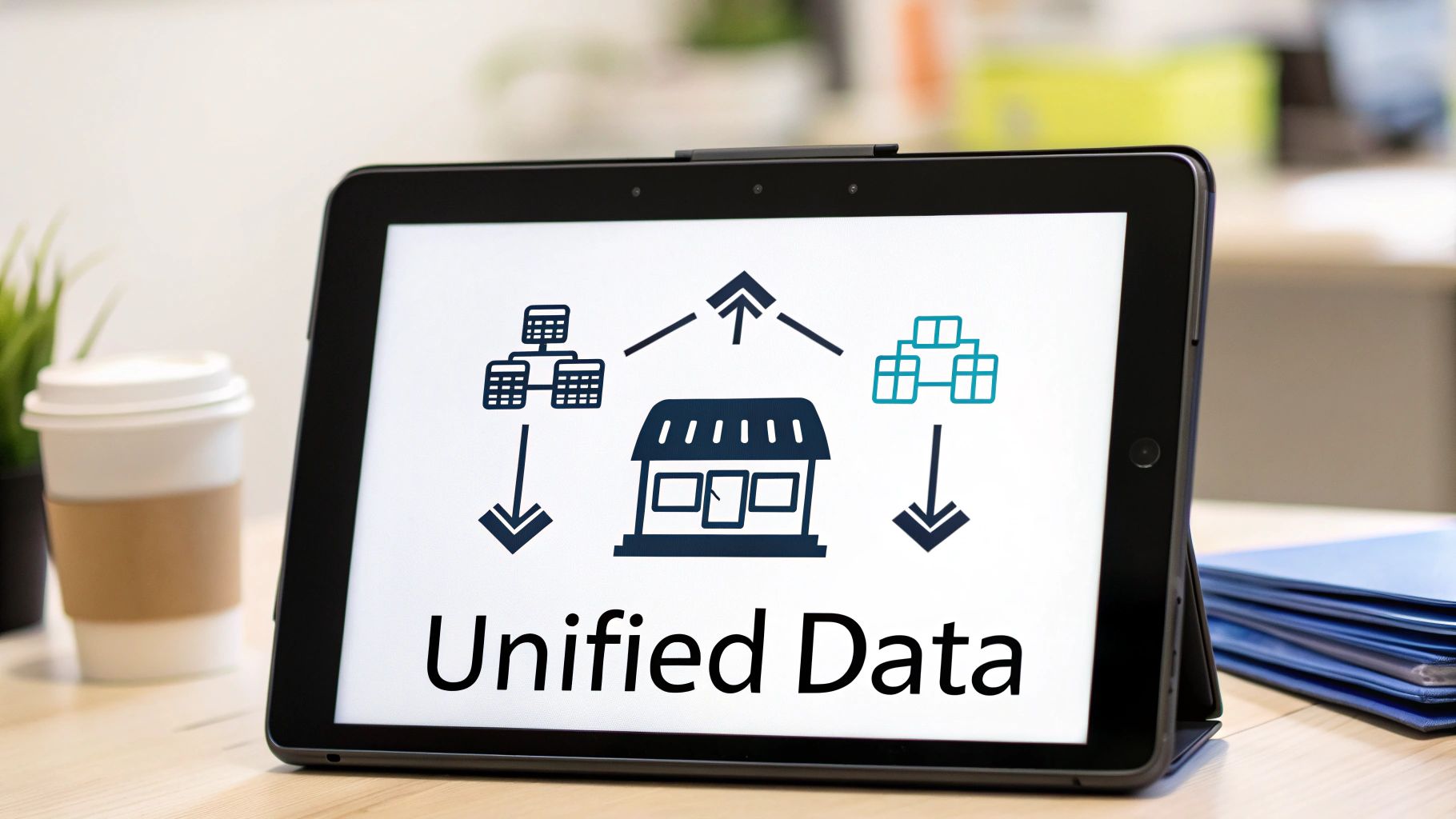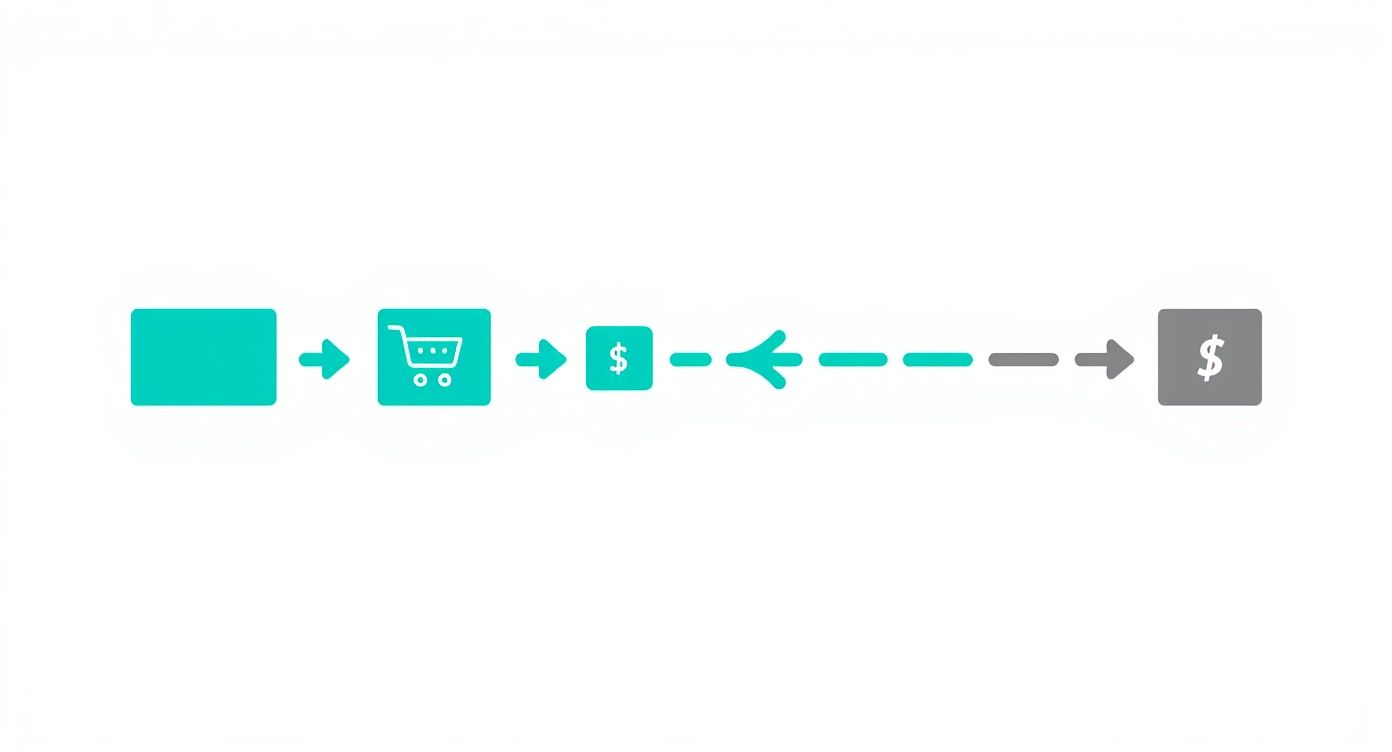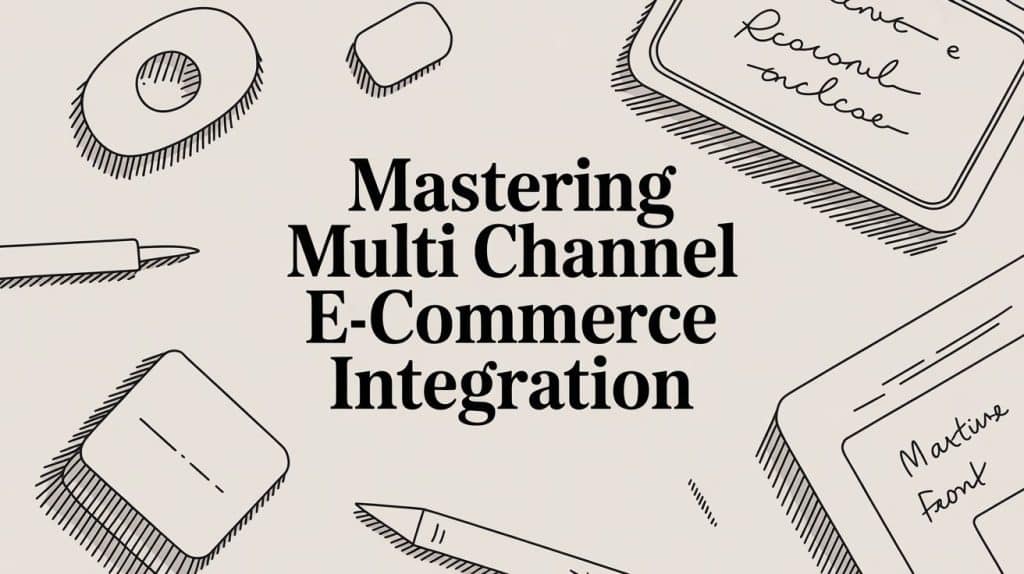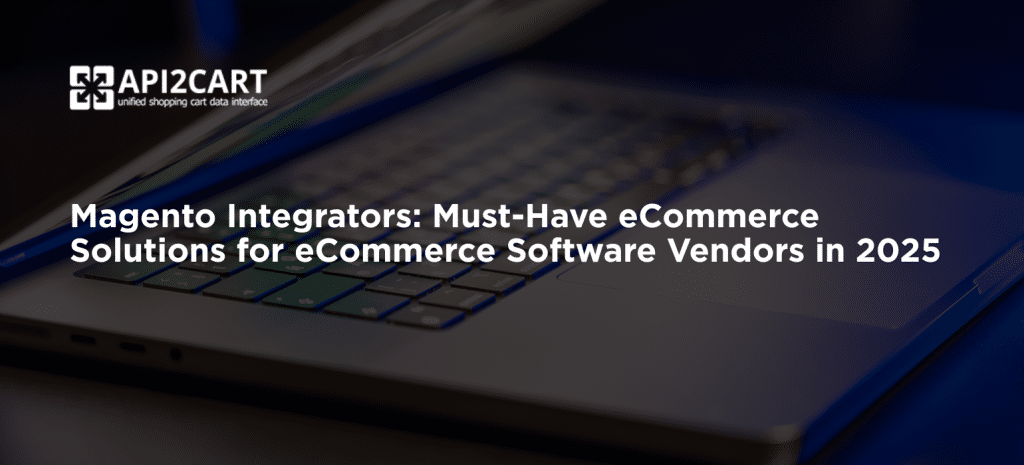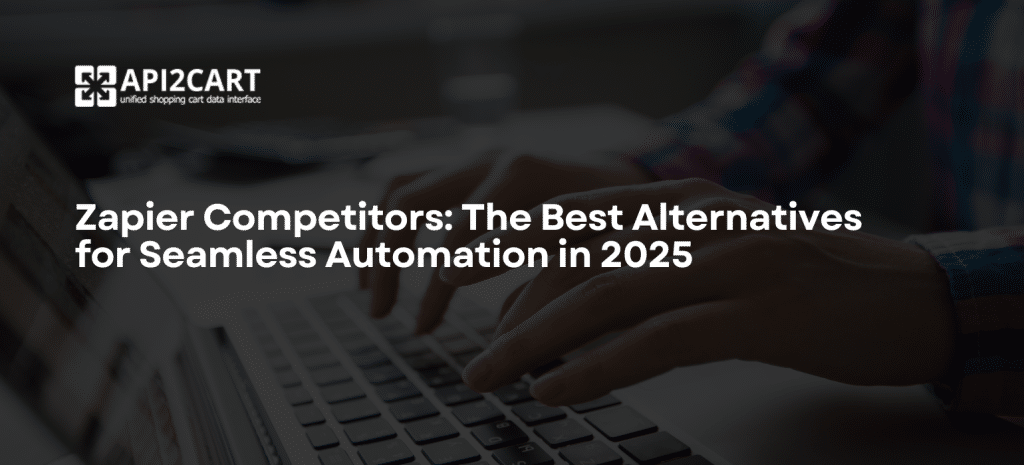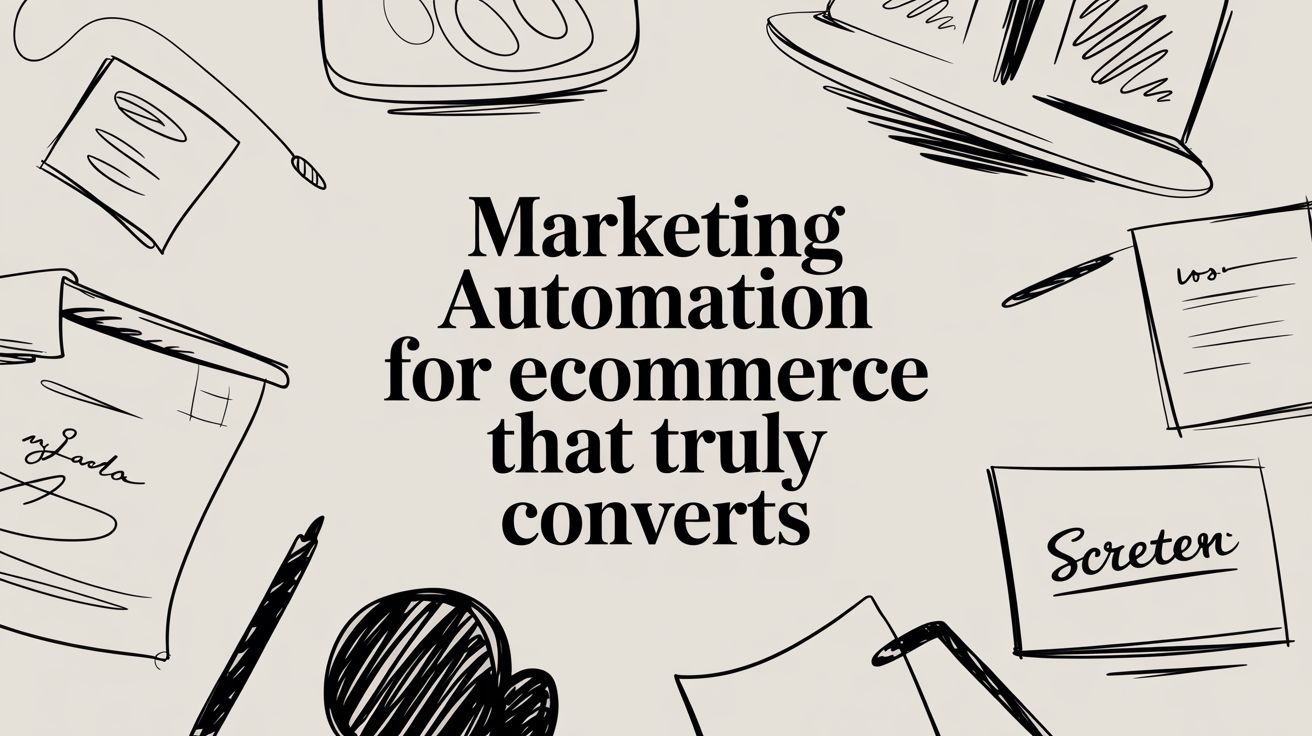
Marketing automation for ecommerce isn't just about sending scheduled emails. It's about using software to automate entire marketing workflows—from segmenting customers to launching ad campaigns—so you can move beyond generic blasts and create intelligent, behavior-driven experiences that feel personal to every single shopper. This shift from manual, repetitive tasks to automated, personalized journeys is what separates the brands that scale from those that get left behind.
Why Smart Automation Is Your New Growth Engine
Let's be blunt: manual marketing doesn't scale. As your store grows, so does the complexity of managing customer relationships. Pretty soon, trying to personally track every abandoned cart, every new subscriber, and every repeat buyer becomes completely impossible. This is where automation flips the script, turning your operations from reactive to proactive.
Instead of just pushing out campaigns, smart automation creates dynamic, one-to-one conversations based on what a customer actually does. A shopper who views a product three times gets a completely different message than a first-time visitor. This level of personalization is no longer a nice-to-have; it's a core expectation that directly impacts your bottom line.
Your Automation Building Blocks
To get these intelligent systems humming, you need to get comfortable with a few fundamental concepts. These are the gears that make the entire machine work.
We can break these down into a simple table to see how they fit together.
| Concept | What It Means for Your Store | A Real-World Example |
|---|---|---|
| Triggers | These are the specific actions or events that kick off an automated workflow. Think of them as the "if this happens..." part. | A customer signs up for your newsletter, makes their second purchase, or leaves an item in their cart for over an hour. |
| Workflows | A workflow is the sequence of actions that follows a trigger. This is the "...then do that" part of the equation. | An "abandoned cart" trigger might send a reminder email after one hour, then a discount offer 24 hours later if they haven't bought yet. |
| Segmentation | This is how you group customers based on shared traits or behaviors, like purchase history, location, or how often they engage. | You could create a segment of "VIPs" who have spent over $500, or a group of "at-risk" customers who haven't purchased in 90 days. |
Mastering these three components is what allows you to build sophisticated, high-performing automations that feel seamless to the customer.
The real power of marketing automation for ecommerce lies in its ability to deliver hyper-relevant experiences at scale. It’s not just about saving time; it's about building stronger customer relationships that drive sustained revenue and loyalty.
Driving Revenue with Intelligent Workflows
The future of ecommerce growth is already here, and it’s powered by advanced AI marketing automation solutions. This technology isn't just a trend; it's a vital tool, and adoption rates are climbing fast. By 2025, it's expected that 79% of marketers will automate parts of their customer journey.
The results speak for themselves. Automated workflows, like post-purchase follow-ups or win-back campaigns, can generate up to 30 times more revenue per recipient than your standard, one-off email campaigns. That's a massive difference.
By getting these core concepts right, you're setting the stage for a more efficient, profitable, and customer-focused business. To dive deeper, you can learn more about how powerful ecommerce automation can be in our detailed guide.
Unlocking Your Data with Unified Integration
Let's be honest—powerful automation is built on a foundation of clean, accessible data. Without a reliable way to know what your customers are doing, your workflows are just expensive guesswork. The real punch of your marketing automation for ecommerce strategy comes directly from the quality and timeliness of the data you can pull from your merchants' stores.
This means you need a live feed of what’s happening. Every automated sequence, from a simple welcome email to a complex win-back campaign, is kicked off by a specific event or data point.
The Two Pillars of Data Synchronization
To get these automations firing, you have to get data out of all those different shopping carts and into your system. There are really two main ways to do this, and you’ll need both to build a solid architecture.
Real-Time Webhooks: Think of webhooks as instant alerts. They’re automated messages an app sends the moment something happens. This is perfect for time-sensitive triggers, like an abandoned cart. When a shopper leaves items behind, the shopping cart can ping your system instantly, letting you fire off a recovery email within the hour.
Scheduled API Calls: API calls, or "polling," is when you proactively ask a platform for data at set times. This approach is better suited for less urgent tasks and for building rich customer segments. For example, you might run a job every night to sync all new orders and customer profiles to update your database, calculate lifetime value, and tag your VIPs.
A truly robust strategy uses both. You need the instant reaction time of webhooks for in-the-moment marketing and the deep data from scheduled calls for strategic planning and segmentation. The problem? Every eCommerce platform—from Shopify to WooCommerce to Magento—handles these connections completely differently.
The Integration Headache and How to Solve It
Imagine your marketing automation software needs to support merchants on a dozen different eCommerce platforms. Your dev team would have to build, test, and maintain a separate, unique integration for each one. We're talking different API structures, different authentication methods, and totally different ways of managing webhooks.
This approach is a massive drain on time and money. Your engineering resources get stuck doing "plumbing" instead of building the cool features that actually make your software stand out. This is where a unified API changes the game.
Instead of building a dozen brittle bridges, a unified API lets you build one solid connection. It acts as a universal translator, speaking the unique language of each shopping cart so your system doesn't have to.
Services like API2Cart provide this unified integration layer. By connecting to API2Cart's single API, you get access to data from over 40 different shopping platforms. It dramatically simplifies the entire data-gathering process.
How API2Cart Speeds Up Automation Use Cases
Let's look at how this simplifies common automation tasks and dramatically speeds up development. Instead of wrestling with a dozen different systems, you can perform these actions through one consistent set of commands.
Retrieving Order History for Segmentation: To build a "repeat customer" segment, you need every customer's full order history. With API2Cart, you use a single method like
order.listto grab this data, whether the store is on BigCommerce or Squarespace. This avoids weeks of coding custom logic for each platform's unique order structure.Subscribing to Cart Updates in Real-Time: An abandoned cart workflow needs to know when a cart is created or updated. API2Cart lets you register a webhook for an event like
cart.add_itemacross all supported platforms with a single API call, standardizing the entire setup. This means you can launch a reliable abandoned cart feature for all your clients simultaneously, not one platform at a time.Accessing Rich Customer Profiles for Personalization: For any real personalization, you need rich customer data—names, emails, shipping addresses. A method like
customer.infogives you a standardized data structure for every shopper, making it simple to populate your CRM or email platform. This unified data format saves countless hours of data mapping and transformation.
This approach turns the challenge of customer data integration in eCommerce from a major engineering roadblock into a manageable task. You can get a much deeper look into the specifics in our comprehensive guide on customer data integration in ecommerce.
By using a unified API, you sidestep the enormous cost and complexity of building and maintaining individual integrations. This frees up your team to focus on what really matters: designing and implementing powerful marketing automation workflows that actually drive revenue and build lasting customer relationships.
Designing Workflows That Actually Drive Revenue
Now that your data is flowing, it's time to put it to work. This is the fun part—where you build the automated journeys that bring back lost sales, delight new customers, and create brand loyalists.
Look, effective marketing automation for ecommerce isn't about having a hundred different complex workflows. It’s about nailing the handful of essential ones that deliver the biggest impact.
We’re going to walk through three core blueprints that should be the foundation of any automation strategy. These aren't just abstract ideas; they're proven, data-driven sequences designed to hit customers at exactly the right moment. For each one, we'll break down the triggers, timing, and personalization that make them so effective.
The Classic Abandoned Cart Recovery
Cart abandonment is a multi-trillion-dollar headache for online stores. But it's also your single biggest opportunity to win back revenue. A perfectly timed, well-crafted message can easily convince a good chunk of those shoppers to finish their purchase. The secret is a multi-step sequence that blends helpfulness with a little bit of urgency.
Here’s a blueprint for an abandoned cart series that works:
Email 1 (Send 1-2 hours after abandonment): The first touchpoint should be all about customer service. The trigger is a
cart.updateevent, followed by a short period of inactivity. Frame the message as a gentle reminder: "Did you run into trouble?" or "We saved your items for you." Make the link back to their cart impossible to miss. Hold off on the discounts for now—you’d be surprised how many people convert with just a simple nudge.Email 2 (Send 24 hours after abandonment): If they haven't come back yet, it's time to sweeten the deal. This email can remind them why the products are great, maybe by featuring a few customer reviews. You can also tackle common objections, like shipping costs. A small incentive, like free shipping or a 10% discount, often does the trick here.
Email 3 (Send 48-72 hours after abandonment): This is your last shot. Create a little urgency by letting them know their cart is about to expire or their special discount is ending. Give them one last reminder of your brand's value. If they still don’t bite, it’s crucial to automatically remove them from this workflow. You don't want to become annoying.
Keep in mind, the abandoned cart trigger has to be lightning-fast. Using a unified API like API2Cart to set up webhooks for cart events ensures you get this data in near real-time. That lets you fire off your recovery sequence when it matters most—right away.
Nurturing New Customers with Post-Purchase Workflows
The moments right after a customer clicks "buy" are pure gold. They're excited, engaged, and paying attention. A solid post-purchase workflow does more than just send a receipt; it builds trust, educates the customer, and paves the way for the next sale.
This entire sequence kicks off with an order.add event, and the main goal is to build a real relationship.
Immediate Action (Order Confirmation): Go beyond the boring, standard transactional email. Use this moment to welcome them into your community. Maybe share a link to a helpful guide on using their new product or invite them to follow you on social media.
Shipping & Delivery Updates: Automate your notifications using
order.shipment.addevents. Don't just dump a tracking number in their inbox. Build anticipation! "Your order is on its way!" along with an estimated delivery date helps manage expectations and keeps them excited.Review Request (7-14 days post-delivery): Timing is everything here. You have to wait until they've actually had time to experience the product. Personalize the email by including the product's name and image. A direct link to the review form makes it dead simple for them to share their thoughts and drastically increases response rates.
Cross-Sell Opportunity (21-30 days post-purchase): Now that they've used and hopefully love your product, it’s the perfect time for a smart recommendation. Pull the product data from their original order to suggest something complementary. If they bought a coffee maker, your workflow could automatically send an email featuring your best-selling coffee beans.
Winning Back Customers Who Have Gone Quiet
Let's be real—not every customer is going to stick around forever. Some will eventually go quiet. A proactive win-back campaign uses their purchase history to re-engage these customers before you lose them for good. This is way cheaper than trying to acquire a brand-new customer.
The trigger here is simply a calculated period of inactivity—say, 90 days since their last purchase.
The "We Miss You" Email: The first message should be light and friendly. Remind them what they loved about your brand or show off some of the cool new things you've launched since they've been away. Sometimes, just popping back into their inbox is enough to bring them back.
The Incentive Offer: If the first email didn’t work, follow up a week later with an offer they can't ignore. This needs to be better than your everyday promotions. Think 20% off or a special gift with their next purchase. Frame it as an exclusive "welcome back" gift just for them.
The Final Survey/Last Chance: Still no response? Send one last email asking for feedback. A simple, one-question survey like, "Why haven't you shopped with us lately?" can give you incredibly valuable insights. It also gives you one final chance to win them back with a personalized offer based on their response.
The impact of good marketing automation on ecommerce is undeniable. Automated emails consistently blow manual campaigns out of the water. We're talking open rates jumping from 25.2% to 42.1%, click-through rates improving from 1.5% to 5.4%, and conversion rates that are nearly four times higher.
These blueprints are a fantastic starting point. For more ideas, be sure to check out our guide on 6 important email workflows for marketing automation. The real key to success is to launch these proven winners, meticulously track their performance, and then tweak them over time to make them even better.
Building Customer Segments That Convert
If you're blasting the same generic message to every single customer, you're taking a one-way trip to their spam folder. Smart marketing automation for ecommerce isn't about shouting louder; it's about segmentation—the art of grouping customers based on what they do, not just who they are. This is how you stop talking at everyone and start having real conversations with the right people at the right time.
Forget about those old, static lists based on location or gender. The real magic happens when you create dynamic, behavior-based segments. These groups update themselves automatically as customers browse, buy, and interact with your store, letting you deliver the kind of personalization that actually drives sales.
From Basic Data to High-Value Segments
You can't build great segments on flimsy data. The foundation has to be solid, and that means knowing a customer's whole story. We're talking about their complete order history, how often they buy, which product categories they love, and their total lifetime spend. Just a name and email won't cut it.
Trying to stitch this data together manually from a dozen different shopping carts is a nightmare. It's practically impossible. This is exactly where a unified integration tool like API2Cart becomes your most valuable player. It acts as a single, reliable pipeline, pulling all the crucial customer and order data you need from platforms like Shopify, Magento, and WooCommerce. With API methods like customer.list and order.list, you can consistently fetch the raw ingredients for building powerful, money-making segments.
This flow chart gives you a bird's-eye view of how customer actions generate the data points that fuel both segmentation and revenue.
What this really shows is that every step in the customer journey—adding to a cart, making a purchase, even returning an item—is more than a transaction. It's a data signal. A clue. And these clues are what power your most effective automation workflows.
Actionable Customer Segments You Can Build Today
Once your data is flowing in, the fun begins. You can start grouping customers into strategic segments that go way beyond simple labels. Think of them as audiences primed for specific, hyper-relevant campaigns that are designed to get a reaction.
Here are a few essential segments you can start building right away:
High-Value VIPs: These are your rockstars, the customers who keep coming back. You can spot them by setting a threshold for lifetime value (say, anyone who has spent over $500) or order count (more than 5 purchases). This is the group you shower with exclusive perks, early access to new drops, and personal thank-you notes.
At-Risk Customers: A customer who used to buy every month but hasn't been seen in 90 days is a flashing red light. They're a valuable relationship that's about to go cold. By analyzing the purchase dates in their order history, you can automatically tag them as "at-risk" and drop them into a win-back campaign with an irresistible offer.
Potential Brand Advocates: Who just bought from you for the third time this month? These are your advocates-in-waiting. Their excitement is at its peak, making it the perfect moment to ask for a review, prompt a social media share, or invite them to your referral program.
One-Time Buyers: It's a classic eCommerce problem: a huge chunk of your customers make one purchase and then disappear forever. By segmenting these users, you can hit them with a targeted post-purchase series that shows off your brand's personality and gives them a compelling reason to make that all-important second purchase.
A huge advantage of pulling data through a unified API is that you can build these segments with one set of rules, no matter the eCommerce platform. For instance, you can calculate a customer's total spend by summing the
total_pricefield from all their orders—it doesn't matter if one order came from a WooCommerce store and another from BigCommerce.
This targeted approach is what makes your marketing feel relevant and personal. Instead of a generic email blast, your VIPs get treated like royalty and your at-risk customers get the gentle nudge they need to come back. This is the heart and soul of a conversion-focused automation strategy.
How to Measure and Optimize Your Automation
Launching your automated workflows is a huge step, but the real work starts now. The secret to long-term success with marketing automation for ecommerce isn't just launching campaigns; it's creating a constant feedback loop where performance data tells you exactly what to do next. You have to track, test, and tweak your strategy relentlessly to make sure your efforts are paying off.
This whole process kicks off with a simple question: what does a "win" look like for each workflow? It’s easy to get fixated on vanity metrics like open and click rates. While they’re good for a quick health check, they don't tell you the full story about your bottom line. You need to be looking at the KPIs that connect directly to revenue and customer health.
Key Performance Indicators That Actually Matter
To get a true sense of your automation’s impact, you need to zoom in on a few critical metrics. Think of each one as a different lens for viewing performance—together, they give you a complete picture of what's working and what's not.
- Conversion Rate: This is the most direct measure of success. It's the percentage of people who received your message and then completed the desired action, whether that's finishing a purchase or using a discount code.
- Revenue Per Recipient (RPR): This is a powerhouse metric. Just divide the total revenue a workflow generates by the number of people who received it. This tells you the exact monetary value of every single email you send.
- Customer Lifetime Value (CLV): Keep a close eye on how your automation influences long-term spending. A well-executed post-purchase series, for instance, should cause a noticeable lift in CLV over time.
- Workflow Attrition Rate: How many users are unsubscribing or just tuning out during a specific automation? A high attrition rate is a massive red flag that your messaging, timing, or offer is off the mark.
Embrace A/B Testing for Constant Improvement
Once you’ve got your baseline numbers, it's time to start optimizing. The best way to do this is with disciplined A/B testing. The idea is simple: compare two versions of a single element to see which one performs better. The key is to avoid testing everything at once; focus on making small, deliberate changes.
Here are a few classic A/B tests you can run on your core workflows:
- Abandoned Cart Series: Test your subject lines. Pit something straightforward like "You left something behind" against a more urgent version like "Your cart expires soon!" to see what drives more clicks.
- Post-Purchase Nurturing: Play with the timing of your review request. Does asking for feedback after 7 days get a better response than waiting for 14 days?
- Customer Win-Back Campaign: Experiment with your offer. Does a 20% discount bring back more lapsed customers than a "Free Gift with Purchase" incentive?
The return on investment (ROI) from marketing automation in ecommerce is seriously impressive. Research shows businesses can see an average ROI of 544% over three years—that's $5.44 back for every dollar spent. A big reason for this is that better lead nurturing can boost qualified leads by as much as 451%.
To really dial in these optimizations, you need data, and you need it fast. Understanding how to use platforms for real-time e-commerce analytics is what separates the pros from the amateurs. The faster you can see what's working, the quicker you can double down on it. If you treat your automation as a living, breathing system instead of a "set it and forget it" tool, you’ll guarantee it remains a powerful engine for your store’s growth.
Frequently Asked Questions
Jumping into marketing automation for your store can feel like a big step, and it's natural to have a few questions. Let's tackle some of the most common ones I hear from merchants.
How Is This Different from Regular Email Marketing?
This is a great question, and the difference is huge. Think of standard email marketing as a megaphone: you send one message, like a weekly newsletter or holiday promo, to a big list all at once. It's a one-to-many approach.
Marketing automation for ecommerce, on the other hand, is like having a personal conversation with each customer. It's not about manual "blasts." Instead, it uses specific customer actions as triggers to send the perfect message at the exact right time.
Here’s a simple comparison:
- Email Marketing: You decide to send a 15% off coupon to your entire list on Tuesday at 10 AM.
- Marketing Automation: A customer adds an item to their cart but leaves. An hour later, an automated workflow sends them a reminder. If they still haven't purchased 24 hours later, the system follows up with a small incentive. It's all personalized and runs on its own.
When Can I Expect to See Results?
You'll see some wins almost immediately. A well-tuned abandoned cart sequence, for instance, can start recovering sales within the first few days. Generally, you can expect an initial lift in conversions and revenue within the first 30 to 60 days after launching your core workflows.
But the real magic of automation is a long game. The biggest payoffs come from building stronger customer relationships over time. After six months to a year, you should see significant, measurable growth in metrics like customer lifetime value (CLV) and repeat purchase rates as your post-purchase and win-back flows do their work.
Can Small Businesses Afford and Manage This?
Absolutely. Automation isn't just for enterprise giants anymore. The trick for a smaller business is to start smart. Don't try to boil the ocean by building a dozen complex workflows from day one. Instead, pick your single biggest pain point—which for most stores is cart abandonment—and nail that first.
For the B2B SaaS companies serving these merchants, the real challenge is often the cost and headache of integrating with dozens of different shopping carts. This is where a unified API like API2Cart completely changes the game.
Instead of building and maintaining separate, fragile connections to Shopify, WooCommerce, BigCommerce, and more, a marketing automation platform can build just one integration to API2Cart. This is exponentially faster and cheaper, making it possible to offer powerful, data-driven automation to small business clients without the massive engineering overhead.
How Does API2Cart Specifically Help with Automation?
Think of API2Cart as the universal translator between your marketing automation software and all the different eCommerce platforms your clients use. It standardizes the data, making it incredibly simple to power your automation flows.
Here are a few real-world examples of how it works:
- Abandoned Cart Recovery: You can use API2Cart's webhooks to get an instant notification (
cart.create,cart.add_item) the moment a shopper bails. That real-time trigger is what makes a timely, high-converting recovery email possible. - Post-Purchase Nurturing: When an order is placed (
order.add) or fulfilled (order.shipment.add), API2Cart sends an immediate alert. Your platform can use this to kick off an entire post-purchase series—order confirmations, shipping updates, and review requests—all automatically. - Smart Segmentation: Let's say you want to build a VIP segment. You can use the
order.listmethod to pull a customer's full purchase history. By summing up their order totals, you can calculate their lifetime value on the fly and drop them into the right segment, no matter which eCommerce platform they're on.
By providing one consistent, reliable API for all these crucial actions, API2Cart lets you focus on what you do best: building amazing automation features, not wrestling with countless integration quirks.
Ready to unlock data from over 40 shopping platforms and supercharge your marketing automation software? With API2Cart, you can build one powerful integration to access the customer, order, and product data you need. Start your free 30-day trial and see how our unified API can save you months of development time.

